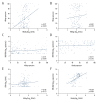Different Mechanisms May Exist for HBsAg Synthesis and Secretion During Various Phases of Chronic Hepatitis B Virus Infection
- PMID: 28321112
- PMCID: PMC5370389
- DOI: 10.12659/msm.902889
Different Mechanisms May Exist for HBsAg Synthesis and Secretion During Various Phases of Chronic Hepatitis B Virus Infection
Abstract
BACKGROUND The aim of this study was to characterize the expression and secretion of hepatitis B surface-antigen (HBsAg) in the hepatocytes of hepatitis B virus (HBV)-infected patients at different phases of infection; as such, the association of intrahepatic HBsAg expression with virological markers and the histological characteristics were analyzed. MATERIAL AND METHODS 302 chronic HBV infection patients who had not received antiviral therapy were stratified by HBeAg status. The proportion of HBsAg-positive cells was used as an indicator for HBsAg expression level. RESULTS In HBeAg-positive patients, there was a significant correlation between serum HBsAg and serum HBV DNA levels (r=0.569, p<0.001). Intrahepatic HBsAg expression and serum HBsAg level in HBeAg-positive patients were higher than those in HBeAg-negative patients (p=0.002 and p<0.001, respectively). A significant correlation between serum HBsAg level and intrahepatic HBsAg expression was found in HBeAg-negative patients (r=0.377, p<0.001), but not in HBeAg-positive patients (r=0.051, p=0.557). Very interestingly, the correlation between serum HBsAg level and HBsAg expression in hepatocytes gradually increased along with disease progression through the immune-tolerant, immune-clearance, inactive, and recovery phases of HBV infection (r=-0.184, 0.068, 0.492, and 0.575; and p=0,238, 0,722, 0.012, and 0.002, respectively). CONCLUSIONS Different mechanisms may be involved in HBsAg synthesis and secretion in different phases of chronic HBV infection.
Conflict of interest statement
No conflict of interest was declared by the authors.
Figures




Similar articles
-
Analysis of intrahepatic total HBV DNA, cccDNA and serum HBsAg level in Chronic Hepatitis B patients with undetectable serum HBV DNA during oral antiviral therapy.Clin Res Hepatol Gastroenterol. 2017 Dec;41(6):635-643. doi: 10.1016/j.clinre.2017.03.004. Epub 2017 Apr 21. Clin Res Hepatol Gastroenterol. 2017. PMID: 28438570
-
Serum Hepatitis B Virus DNA, RNA, and HBsAg: Which Correlated Better with Intrahepatic Covalently Closed Circular DNA before and after Nucleos(t)ide Analogue Treatment?J Clin Microbiol. 2017 Oct;55(10):2972-2982. doi: 10.1128/JCM.00760-17. Epub 2017 Jul 26. J Clin Microbiol. 2017. PMID: 28747369 Free PMC article.
-
Clinical significance of serum HBsAg levels and association with liver histology in HBeAg positive chronic hepatitis B.J Clin Virol. 2013 Aug;57(4):323-30. doi: 10.1016/j.jcv.2013.04.012. Epub 2013 Jun 2. J Clin Virol. 2013. PMID: 23731848
-
Natural history of chronic hepatitis B virus infection: an immunopathological study.J Gastroenterol Hepatol. 1997 Oct;12(9-10):S218-22. doi: 10.1111/j.1440-1746.1997.tb00503.x. J Gastroenterol Hepatol. 1997. PMID: 9407340 Review.
-
Liver Fibrosis in the Natural Course of Chronic Hepatitis B Viral Infection: A Systematic Review with Meta-Analysis.Dig Dis Sci. 2022 Jun;67(6):2608-2626. doi: 10.1007/s10620-021-07009-y. Epub 2021 May 18. Dig Dis Sci. 2022. PMID: 34008117
Cited by
-
Hepatitis B virus S gene therapy with 10-23 DNAzyme delivered by chitosan-g-stearic acid micelles.RSC Adv. 2019 May 15;9(27):15196-15204. doi: 10.1039/c9ra00330d. eCollection 2019 May 14. RSC Adv. 2019. PMID: 35514820 Free PMC article.
-
Analysis of S gene characteristic sequences and changes in properties of protein expression in HBV ASCs with low-level HBsAg.Front Med (Lausanne). 2022 Sep 14;9:948842. doi: 10.3389/fmed.2022.948842. eCollection 2022. Front Med (Lausanne). 2022. PMID: 36186824 Free PMC article.
-
Hepatitis B infection and intrahepatic cholestasis of pregnancy: A systematic review and meta-analysis.Medicine (Baltimore). 2020 Jul 31;99(31):e21416. doi: 10.1097/MD.0000000000021416. Medicine (Baltimore). 2020. PMID: 32756142 Free PMC article.
-
Hepatitis B Core-Related Antigen as Surrogate Biomarker of Intrahepatic Hepatitis B Virus Covalently-Closed-Circular DNA in Patients with Chronic Hepatitis B: A Meta-Analysis.Diagnostics (Basel). 2021 Jan 28;11(2):187. doi: 10.3390/diagnostics11020187. Diagnostics (Basel). 2021. PMID: 33525443 Free PMC article. Review.
References
-
- Trepo C, Chan HL, Lok A. Hepatitis B virus infection. Lancet. 2014;384:2053–63. - PubMed
-
- Chan HL, Wong VW, Wong GL, et al. Early hepatitis B virus DNA suppression can predict virologic response to peginterferon and lamivudine treatment. Clin Gastroenterol Hepatol. 2008;6:1022–26. - PubMed
-
- Liaw YF. Clinical utility of hepatitis B surface antigen quantitation in patients with chronic hepatitis B: A review. Hepatology. 2011;53:2121–29. - PubMed
MeSH terms
Substances
LinkOut - more resources
Full Text Sources

